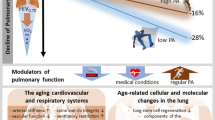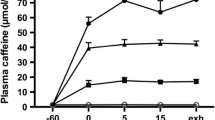Abstract
Although it is accepted that an important correlation exists between the physical exercise and the oxidative stress status, the data regarding the levels of the main oxidative stress markers after physical training have been difficult to interpret and a subject of many controversies. There are also very few studies regarding the effects of short-time exercise on the oxidative stress status modifications. Thus, in the present report we were interested in studying the modifications of some oxidative stress markers (two antioxidant enzymes-superoxide dismutase and glutathione peroxidase, a lipid peroxidation parameter — malondyaldehide, the total antioxidant status and protein carbonyl levels), from the serum of rats that were subject to one bout of five minutes exercise on a treadmill, when compared to a control sedentary group. In this way, we observed a decrease of superoxide dismutase specific activity in the rats which performed the exercises. Still, no modifications of glutathione peroxidase specific activity were found between groups. In addition, increased levels of malondyaldehide and protein carbonyls were observed in the rats subjected to exercises. In conclusion, our data provides new evidence regarding the increase of the oxidative stress status, as a result of a 5-minutes bout of treadmill exercising in rats, expressed through a decrease in the SOD specific activity and the total antioxidant status and also an increase of the lipid peroxidation and protein oxidation processes.
Similar content being viewed by others
References
Sies H. Oxidative stress: oxidants and antioxidants. Experimental Physiology 1997; 82: 291–295
Reid MB, Khawli FA, Moody MR. Reactive oxygen in skeletal muscle. III. Contractility of unfatigued muscle. J Appl Physiol 1993; 75: 1081–1087
Reid MB. Redox modulation of skeletal muscle contraction: what we know and what we don’t. J Appl Physiol 2001; 90: 724–731
Powers SK, Jackson MJ. Exercise-induced oxidative stress: cellular mechanisms and impact on muscle force production. Physiol Rev 2008; 88: 1243–1276
Barclay JK, Hansel M. Free radicals may contribute to oxidative skeletal muscle fatigue. Can J Physiol Pharmacol 1991; 69: 279–284
Reid MB, Shoji T, Moody MR, Entman ML. Reactive oxygen in skeletal muscle. II. Extracellular release of free radicals. J Appl Physiol 1992; 73: 1805–1809
Ji LL. Antioxidants and Oxidative Stress in Exercise. Exp Biol Med 1999; 222: 283–292
Leichtweis S, Leeuwenburgh C, Fiebig R, Parmelee D, Yu XX, Ji LL. Rigorous swim training deteriorates mitochondrial function in rat heart. Acta Physiol Scand 1997; 160: 139–148
Evelo CT, Palmen NG, Artur Y, Janssen GM. Changes in blood glutathione concentrations, and in erythrocyte glutathione reductase and glutathione S-transferase activity after running training and after participation in contests. Eur J Appl Physiol 1992; 64: 354–358
Robertson JD, Maughan RJ, Duthie GG, Morrice PC. Increased blood antioxidant systems of runners in response to training. Clin Sci 1991; 80: 611–618
Marin E, Kretzschmar M, Arokoski J, Hanninen O, Klinger W. Enzymes of glutathione synthesis in dog skeletal muscle and their response to training. Acta Physiol Scand 1993; 147: 369–373
Ohno H, Suzuki K, Fujii J, Yamashita H, Kizaki T, Oh-ishi S, Taniguchi N. Superoxide dismutases in exercise and disease. Exercise and Oxygen Toxicity 1994; 1: 127–161
Ji LL, Dillon D, Wu E. Alteration of antioxidant enzymes with aging in rat skeletal muscle and liver. Am J Physiol 1990; 258: 918–923
Powers SK, Criswell D, Lawler J, Ji LL, Martin D, Herb R, Dudley G. Influence of exercise intensity and duration on antioxidant enzyme activity in skeletal muscle differing in fiber type. Am J Physiol 1994; 266: 375–380
Tiidus PM, Pushkarenko J, Houston ME. Lack of antioxidant adaptation to short-term aerobic training in human muscle. Am J Physiol 1996; 271: 832–836
Ji LL. Antioxidant enzyme response to exercise and aging. Med Sci Sports Exerc 1993; 25: 225–231
Leeuwenburgh C, Ji LL. Alteration of glutathione and antioxidant status with exercise in unfed and refed rats. J Nutr 1996; 126: 1833–1843
Leeuwenburgh C, Ji LL. Glutathione depletion in rested and exercised mice: Biochemical consequence and adaptation. Arch Biochem Biophys 1995; 316: 941–949
Laughlin MH, Simpson T, Sexton WL, Brown OR, Smith JK, Korthuis RJ. Skeletal muscle oxidative capacity, antioxidant enzymes, and exercise training. J Appl Physiol 1990; 68: 2337–2343
Ciobica A, Olteanu Z, Padurariu M, Hritcu L. The effects of pergolide on memory and oxidative stress in a rat model of Parkinson’s disease. J Physiol Biochem 2012; 68: 59–69
Ciobica A, Hritcu L, Nastasa V, Padurariu M, Bild W. Inhibition of central angiotensin converting enzyme exerts anxiolytic effects by decreasing brain oxidative stress. Journal of Medical Biochemistry 2011; 30: 109–114
Gurzu C, Artenie V, Hritcu L, Ciobica A. Prenatal testosterone improves the spatial learning and memory by protein synthesis in different lobes of the brain in the male and female rat. Cent. Eur. J. Biol 2008; 3: 39–47
Dillard CJ, Litov RE, Savin WM, Dumelin EE, Tappel AL. Effects of exercise, vitamin E, ozone on pulmonary function and lipid peroxidation. J Appl Physiol 1978; 45: 927–932
Kondo H, Miura M, Itokawa Y. Antioxidant enzyme systems in skeletal muscle atrophied by immobilization. Pflugers Arch 1993; 422: 404–406
Alessio HM, Goldfarb AH. Lipid peroxidation and scavenger enzymes during exercise: Adaptive response to training. J Appl Physiol 1988; 64: 1333–1336
Higuchi M, Cartier LJ, Chen M, Holloszy JO. Superoxide dismutase and catalase in skeletal muscle: Adaptive response to exercise. J Gerontol 1985; 40: 281–286
Powers SK, Criswell D, Lawler J, Ji LL, Martin D, Herb R, Dudley G. Influence of exercise intensity and duration on antioxidant enzyme activity in skeletal muscle differing in fiber type. Am J Physiol 1994; 266: 375–380
Leeuwenburgh C, Fiebig R, Chandwaney R, Ji LL. Aging and exercise training in skeletal muscle: Response of glutathione and antioxidant enzyme systems. Am J Physiol 1994; 267: 439–445
Hollander J, Fiebig R, Gore M, Bejma J, Ohno H, Ji LL. Superoxide dismutase gene expression: Fiberspecific adaptation to endurance training. Am J Physiol 1999; 277: 856–862
Oh-Ishi S, Kizaki T, Nagaswa J, Izawa T, Komabayashi T, Nagata N, Suzuki K, Taniguchi N, Ohno H. Effects of endurance training on superoxide dismutase activity, content, and mRNA expression in rat muscle. Clin Exp Pharmacol Physiol 1997; 24: 326–332
Ji LL, Fu RG. Responses of glutathione system and antioxidant enzymes to exhaustive exercise and hydroperoxide. J Appl Physiol 1992; 72: 549–554
Sentürk UK, Gündüz F, Kuru O, Aktekin MR, Kipmen D, Yalçin O et al. Exercise-induced oxidative stress affects erythrocytes in sedentary rats but not exercise-trained rats. J Appl Physiol 2001; 91: 1999–2004
Jackson MJ, Khassaf M, Vasilaki A, McArdle F, McArdle A. Vitamin E and the oxidative stress of exercise. Ann NY Acad Sci 2004; 1031: 158–168
Jackson MJ, Pye D, Palomero J. The production of reactive oxygen and nitrogen species by skeletal muscle. J Appl Physiol 2007; 102: 1664–1670
Novelli GP, Bracciotti G, Falsini S. Spin-trappers and vitamin E prolong endurance to muscle fatigue in mice. Free Radic Biol Med 1990; 8: 9–13
Shindoh C, DiMarco A, Thomas A, Manubay P, Supinski G. Effect of N-acetylcysteine on diaphragm fatigue. J Appl Physiol 1990; 68: 2107–2113
Powers SK, DeRuisseau KC, Quindry J, Hamilton KL. Dietary antioxidants and exercise. J Sports Sci 2004; 22: 81–94
Diaz PT, Costanza MJ, Wright VP, Julian MW, Diaz JA, Clanton TL. Dithiothreitol improves recovery from in vitro diaphragm fatigue. Med Sci Sports Exerc 1998; 30: 421–426
Khawli FA, Reid MB. N-acetylcysteine depresses contractile function and inhibits fatigue of diaphragm in vitro. J Appl Physiol 1994; 77: 317–324
Yesilkaya A, Ertug Z, Yegin A, Melikoglu M, Baskurt OK. Deformability and oxidant stress in red blood cells under the influence of halothane and isoflurane anesthesia. Gen Pharmacol. 1998; 31: 33–36
Kotzampassi K, Kolios G, Manousou P, Kazamias P, Paramythiotis D, Papavramidis TS et al. Oxidative stress due to anesthesia and surgical trauma: importance of early enteral nutrition. Mol Nutr Food Res. 2009; 53: 770–779
Author information
Authors and Affiliations
Corresponding author
Additional information
These authors equally contributed to this work (as last and coordinating author).
About this article
Cite this article
Trofin, FP., Ciobica, A., Cojocaru, D. et al. Increased oxidative stress status in rat serum after five minutes treadmill exercise. cent.eur.j.med 9, 722–728 (2014). https://doi.org/10.2478/s11536-013-0329-4
Received:
Accepted:
Published:
Issue Date:
DOI: https://doi.org/10.2478/s11536-013-0329-4




